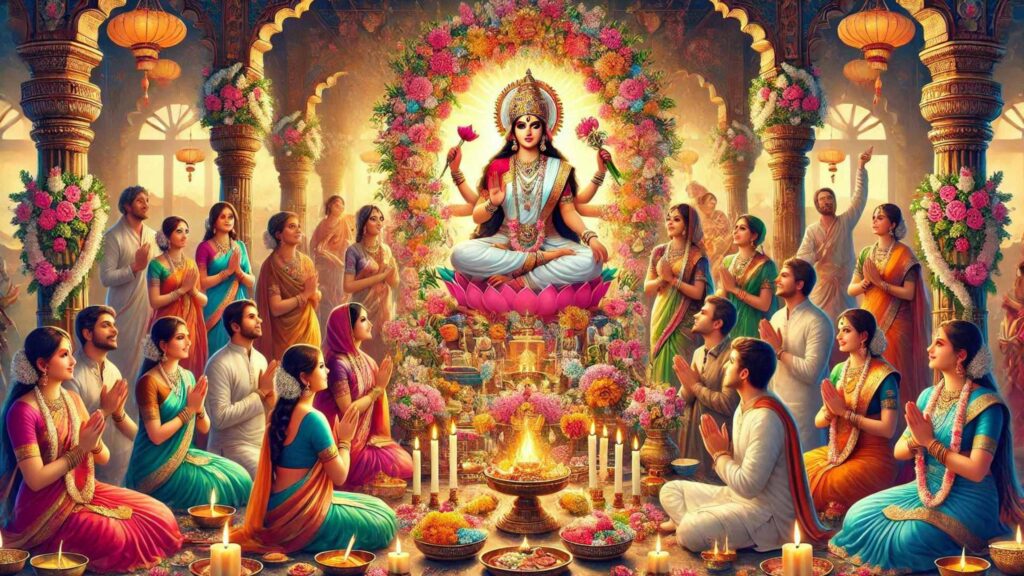How Long Does the Diwali Festival Last? An In-Depth Exploration
Diwali, often referred to as the Festival of Lights, is one of the most celebrated festivals in India and around the world. But how long does Diwali last, and what do the festivities entail? While many recognize Diwali as a single day of celebration, the festival traditionally spans five days, each with its own unique significance, rituals, and cultural importance.
Read More About Hinduism Festivals
This article takes a detailed look at the five days of Diwali, exploring the traditions and stories associated with each, and provides insights into the deeper meanings of this timeless festival.
The Five Days of Diwali
Day 1: Dhanteras (धनतेरस)

Dhanteras marks the beginning of the Diwali festival and is celebrated on the thirteenth day of the lunar fortnight (Trayodashi) in the month of Kartika.
Significance:
- The word “Dhan” means wealth, and “Teras” refers to the thirteenth day.
- This day is dedicated to Lord Dhanvantari, the god of medicine and health, and Kubera, the god of wealth.
Rituals:
- Devotees clean their homes and purchase gold, silver, or utensils, symbolizing prosperity.
- Lamps (diyas) are lit to ward off negative energies and welcome wealth.
- Special prayers are offered to Lord Dhanvantari and Kubera for health and prosperity.
Spiritual Meaning:
Dhanteras emphasizes the importance of health and material well-being as foundational aspects of life.
Day 2: Naraka Chaturdashi (नरक चतुर्दशी)

Also known as Choti Diwali, this day commemorates the victory of Lord Krishna and Satyabhama over the demon Narakasura.
Significance:
- Naraka Chaturdashi symbolizes the triumph of good over evil.
- It serves as a day of purification and cleansing, both physically and spiritually.
Rituals:
- People wake up before sunrise, apply oil and herbal powders, and take a purifying bath to symbolize the removal of negativity.
- Diyas are lit, and small-scale celebrations with sweets and decorations take place.
Spiritual Meaning:
This day is a reminder of the eternal victory of dharma (righteousness) over adharma (unrighteousness).
Day 3: Diwali (Main Day of Lakshmi Puja)

The third day is the most important and widely celebrated day of Diwali. It is observed on Amavasya (the new moon night).
Significance:
- Dedicated to Goddess Lakshmi, the goddess of wealth and prosperity, and Lord Ganesha, the remover of obstacles.
- The day symbolizes the spiritual light that removes the darkness of ignorance.
Rituals:
- Homes are thoroughly cleaned and decorated with rangoli, lights, and flowers to welcome Goddess Lakshmi.
- Lakshmi Puja is performed in the evening, offering prayers and sweets to the goddess.
- Families light diyas and burst firecrackers, symbolizing joy and the removal of negativity.
Spiritual Meaning:
Diwali celebrates inner enlightenment, prosperity, and the divine blessings that guide us in life.
Day 4: Govardhan Puja (अन्नकूट)

The fourth day, also known as Annakut or Govardhan Puja, is celebrated in honor of Lord Krishna.
Significance:
- This day commemorates Krishna’s lifting of Govardhan Hill to protect the villagers of Vrindavan from torrential rains caused by Lord Indra’s wrath.
- It also marks the first day of the Hindu New Year in many regions.
Rituals:
- Devotees prepare elaborate vegetarian meals and offer them to Lord Krishna.
- Govardhan Hill replicas are made using cow dung, symbolizing Krishna’s protection.
- Families pray for blessings, protection, and prosperity.
Spiritual Meaning:
Govardhan Puja teaches us about humility, protection, and the importance of ecological balance.
Day 5: Bhai Dooj (भाई दूज)

The final day of Diwali, Bhai Dooj, celebrates the bond between brothers and sisters.
Significance:
- It is believed that on this day, Yamraj, the god of death, visited his sister Yamuna, and she prayed for his well-being.
- Sisters pray for their brothers’ long life and prosperity, while brothers vow to protect their sisters.
Rituals:
- Sisters perform aarti and apply tilak (a sacred mark) on their brothers’ foreheads.
- Brothers present gifts to their sisters as a token of love and gratitude.
Spiritual Meaning:
Bhai Dooj signifies familial bonds, love, and mutual respect, which are vital for a harmonious society.
Why Does Diwali Last for Five Days?
The five days of Diwali represent a holistic approach to life, encompassing material prosperity, spiritual enlightenment, familial bonds, and ecological awareness. Each day has a unique purpose, allowing individuals to reflect on different aspects of their lives and celebrate their cultural heritage.
Regional Variations in Diwali Celebrations
- North India:
- Focus on Lord Rama’s return to Ayodhya and Lakshmi Puja.
- Grand decorations, firecrackers, and sweets dominate the festivities.
- South India:
- Naraka Chaturdashi takes center stage, celebrating Krishna’s victory over Narakasura.
- Homes are adorned with kolams (rangoli) and oil lamps.
- West India:
- Gujarat celebrates Diwali as the New Year, with an emphasis on business and prosperity.
- Annakut and Govardhan Puja are prominent.
- East India:
- The worship of Goddess Kali is a unique feature of Diwali in Bengal.
- Diyas and Kali Puja rituals are highlights.


